Salt River Project consolidates testing functions with new innovation lab
May 8, 2021
by Peter Maloney
APPA News
May 8, 2021
Arizona public power utility Salt River Project (SRP) recently began operation of its new utility innovation testing laboratory.
The 5,400 square foot Technology Innovation Lab in Scottsdale, Ariz., provides space for SRP employees and contractors working in a variety of functions across the public power utility, including telecommunications; distribution integration; distribution operations; protection, automation and control; power delivery engineering; and power delivery technology services.
“The lab will support the day-to-day activities of these teams as well as longer term testing, proof of concept, and vendor evaluation efforts of new software and hardware solutions to see firsthand how these will work in an isolated environment before fully deploying across SRP’s system,” Tait Willis, director of protection, automation and control at SRP, said in a statement.
The new lab consolidates the lab space that SRP already had. The utility used to have six labs. It now has three. Four of the former labs are now housed in the new lab and two labs – one for customer programs for things such as smart thermostats, the other tests metering technologies– remain at separate locations, though they are being connected to the new lab so they can participate in tests that better replicate the breadth of the utility’s operations.
There was some discussion about bringing all the labs under one roof but limiting the scope of the project made the costs more manageable, Kyle Cormier, director of telecommunications systems at SRP, said. In the past, many of those labs were siloed; now “the new lab provides a more cohesive space for testing and training.”
The new lab also has a small classroom space where vendors and SRP teams can conduct training sessions with engineers and technicians. “Training is a huge area of focus for this lab space,” Willis said. SRP’s engineers and technicians needed “a central space where employees can come to learn maintenance and commissioning practices in a safe environment.”
The idea of creating a single lab for the whole utility had been under discussion at SRP for nearly a decade, but the concept really came together about three or four years ago when SRP hired a consultant to conduct a cyber penetration test. It turned out it was hard to run a useful version of the test because the representations of the utility’s system at the various labs were not consistent.
Instead of testing the robustness of the utility’s cyber security measures, the test showed that the various labs did not accurately reflect the reality of the utility’s system, Cormier said. It became apparent that the utility needed to have “more integration to do end-to-end testing that can look at the system as a whole.”
After about two years of planning, construction of the Technology Innovation Lab began in December of 2019, and it began operation in April 2021.
SRP’s protection, automation, and control department is one of the departments that has already started using the lab’s capabilities. In collaboration with Intel and other utilities, SRP’s team is in the early stages of running tests to evaluate the benefits of virtualizing substation systems.
In the past, substation controls were mostly electro-mechanical with different functions controlled by separate computers. In that configuration, adding a relay to a substation requires a lot of rewiring and physical integration.
If those functions can be virtualized, that is, replicated using software instead of adding another box with dedicated controls to the substation, the utility would be able to perform the same function by adding a new application.
From SRP’s perspective, a virtualized solution would help standardize substation hardware, consolidate and centralize functionality, improve employee safety, and reduce capital investment, as well as operation and maintenance costs.
SRP’s telecom engineering department is using the lab to test firmware for Field Area Network (FAN) Tier 2 radios as a way of improving two-way communications for connected devices. The tests are designed to help determine if new firmware solutions improve communication with SRP’s devices in hard-to-reach areas.
“Right now, we can send information to the device, but we don’t get anything back,” Cormier said. “Two-way communications would yield more information about temperatures and voltage levels and more insight into basic power qualities, which will be helpful as we integrate more renewables into our system.”
Another huge benefit is being better able to test new equipment, Cormier said. Just because a manufacturer’s equipment meets industry standards does not mean it will work well with other components. The Technology Innovation Lab gives SRP the ability to run “end-to-end tests” on new equipment in a more realistic and holistic way, he said.
Power sector explores ways in which to leverage artificial intelligence, machine learning
May 7, 2021
by Paul Ciampoli
APPA News Director
May 7, 2021
The electric power sector is increasingly looking for ways in which to leverage artificial intelligence (AI) and machine learning for its systems as the industry undergoes a digital transformation.
On March 18, the Electric Power Research Institute (EPRI) convened a roundtable that looked at AI and the power sector.
EPRI is leading a collaborative effort (AI.EPRI) between the electric power and AI industries. To kick off a 2021 community-building event series, EPRI hosted the virtual roundtable with executives in both industries.
Arshad Mansoor, President and CEO of EPRI, said “We’re starting a decade where the full digital transformation of how we generate, how we distribute, how we use electricity is going to happen.”
AI “will play a huge role in that digital transformation,” Mansoor said during the roundtable. “The reason this is the decade to seize on is the technology advancement that has happened just in the last five years.”
The use cases for AI are huge, he said. “There are a lot of entities – data companies, universities, technology providers – who are working with our members to shape this future.”
When asked by Heather Feldman Director for R&D at EPRI, to discuss AI use cases in the power sector, Bhavani Amirthalingam, Senior Vice President and Chief Digital Information Officer at Missouri-based investor-owned utility Ameren, mentioned asset health.
“Being able to do predictive, preventative maintenance, condition-based maintenance on key assets I think is a fantastic use case,” Amirthalingam said. “It’s great for customers from a reliability standpoint. It’s great for customers from an affordability standpoint.”
Another roundtable participant, Arun Majumdar, a professor in the Department of Mechanical Engineering at Stanford University, said that “it’s important to point out that the people who are focused on data do not always understand the issues related to the electricity industry and vice versa.”
Majumdar also said that “there are security issues with this, there are privacy issues with this. There needs to be anonymized data sets that could be used and this needs to be at scale and the scalability of organizing data and making it useful is something that the information industry understands very, very well. They have techniques that the electricity industry does not have.”
“I think the topic of data is really very central to how you make AI useful,” said Jatinder Singh, Vice-President, Digital and Data Transformation at Texas public power utility CPS Energy.
“Even if I have data, even if all of us have data, do we have the right tools and talent to do something with that data?” If not, this is one way that data sharing can help, he said.
In a Q&A with the American Public Power Association’s Public Power Current newsletter, Singh noted that he is responsible for developing strategy and multi-year roadmaps for digital capabilities that will elevate customer and employee experiences.
“The roadmap will transform our technological capabilities and the way we work – from technology projects to digital products – from waterfall to agile. In parallel to the digital transformation is the transformation of our data eco-system and governance that will allow us to capitalize on the promising newer emerging technologies,” he said.
Singh was also asked whether there are any projects currently underway at CPS Energy that involve the application of artificial intelligence to the utility’s power system.
“There are several examples of where our teams are currently leveraging machine learning to improve management insights into operations,” he noted.
“The teams are leveraging several data sources for outage prediction for seasonal weather patterns to reduce potential outage duration for customers and engage in preventative maintenance.”
For San Antonio’s wide load forecasting, the team is leveraging machine learning for better demand management. And for vegetation management, the team is at the early stage of leveraging LiDAR and GIS data combined with machine learning to be more effective and efficient in addressing potential vegetation related outages. The team is also leveraging machine learning on AMI data to solve several asset management, maintenance, and demand management use cases, he said.
Meanwhile, Singh elaborated on what he sees as the long-term benefits that the power industry could derive from the use of AI.
“There are at least four areas where I see opportunities for artificial intelligence (AI) to potentially provide meaningful benefits for the energy industry,” he said.
One is asset management. “By leveraging image recognition and data such as GIS and LiDAR, AI will dramatically improve the industry’s efficiency to manage sprawling transmission and distribution assets, which are the highways through which our services are made available to our consumers,” Singh said.
Another benefit is in customer service, he said. Through natural language processing and voice recognition, the industry “can provide personalized, relevant, and convenient access to information and services to new and existing customers in their language and at the time of their preference,” he said.
There could be opportunities to explore how AI could help improve the efficiencies with renewable energy by combining weather data and mechanical devices that will maximize renewable energy generation from solar panels and wind turbines, he said.
Singh also mentioned new solutions. The industry “could generate new revenue sources through services and products, powered by data and AI, that will allow customers to reduce their carbon footprint and power their increasingly electrified lives.”
CPS Energy “is taking a test and learn approach towards several use cases in the above categories. However, there are some potential use cases that we haven’t yet envisioned that are becoming more apparent as the technology and its usage gain maturity within the energy and other industries. We will continue to explore those new opportunities to leverage AI as they present themselves.”
SRP
In 2019, Arizona public power utility Salt River Project (SRP) signed a deal to use AI to improve its information technology (IT) operations. The Phoenix-based public power utility adopted ScienceLogic’s SL1 platform to monitor its IT operations and applications.
In a Q&A with Public Power Current, Joe Kosmal, manager of data center operations at SRP, said that SRP completed phase one of the ScienceLogic implementation in July 2020, which was a value-added replacement of SRP’s legacy IT operations platform.
“We are currently well into our phase two project which includes the advanced capabilities to assess the health, availability, and risk to applications and systems that serve critical business processes in the enterprise,” he said.
Kosmal was asked to discuss how ScienceLogic’s platform has improved SRP’s IT operations since its implementation.
“Since implementation, ScienceLogic has helped us regularly identify issues before they caused impact to the reliability and resiliency of our IT systems,” he said. “This has helped mature our IT operations from reactive monitoring and escalations to proactive monitoring that fosters a stronger partnership with application and system support teams in the organization.”
When asked whether SRP is considering deploying AI in any other parts of its operations beyond IT, he said SRP is exploring use cases for AI in different areas of the utility and evaluating how those capabilities can improve operations and better serve SRP customers.
NYPA
Meanwhile, the New York Power Authority (NYPA) has been awarded two $125,000 grants from the American Public Power Association’s Demonstration of Energy & Efficiency Developments (DEED) program to fund demonstration projects that will analyze the impact of ice on a hydropower plant and test an advanced technology that evaluates the health of high voltage assets in a substation.
The DEED program funds research, pilot projects and educational programs to improve the operations and services of public power utilities.
NYPA will undertake the following projects:
Analyze the Impact of Ice on Hydro Power Resources with Machine Learning: NYPA has had significant power generation losses due to ice blockages near intake valves in the Niagara River and has worked to address the issue with industry groups and other utilities. During the winter, water can become supercooled all the way to the bottom of the river, leading to the formation of frazil ice crystals, anchor ice, or both. Anchor and frazil ice affects water availability estimation by Niagara River Control Center and frazil ice can affect hydropower plan operation since it’s “sticky” and can result in ice formation on the plant’s water turbines. These studies will include using 3-D sonar to quantify the impact of frazil ice on the efficiency of the hydropower units and forecasting the formation of anchor and frazil ice with a look ahead of a few days to a few weeks.
Smart Insulation Condition Monitoring System (CMS) for Substation Assets: A state-of-the-art Condition Monitoring System will be developed to constantly monitor the insulation condition of various high voltage assets (transformers, GIS, switchgears and cables) in a substation. The CMS consists of smart sensing, advanced noise mitigation and artificial intelligence for data interpretation. The system will use an advanced diagnostic technology that recognizes and evaluates defects and provides guidance for maintenance planning. The system will improve the power grid reliability, reduce customer outage costs, and help asset management optimize maintenance and maximize asset life.
NYPA deploys AI-based application
In 2018, NYPA selected C3 IoT to provide a software platform to help NYPA and the state implement and meet its energy efficiency targets.
Under a multi-year, software-as-a-service agreement, NYPA agreed to deploy C3 Energy Management, an AI-based application, as part of New York Energy Manager, NYPA’s advanced, secure energy management center, headquartered in Albany, N.Y. It provides public and private facility operators across New York State with timely data on energy use.
The C3 Energy Management application enables the New York Energy Manager program to aggregate enormous volumes of data, including real-time data from smart meters, building management systems, end-use equipment controls, sensors, weather data, occupancy and daylight data, solar data, and utility bills.
C3 IoT said the application would allow the New York Energy Manager program to employ machine learning at scale, generate insights about individual customers’ energy usage, and deliver personalized recommendations to help customers reduce their energy use.
The company said the software would also allow NYPA to offer its customers services such as building energy load forecasting, fault detection and diagnostics, continuous optimization of energy use, dynamic demand response, solar and energy storage monitoring, and aggregation and dispatch of buildings as distributed energy resources.
New York Energy Manager “is utilizing C3’s Energy Management application to help our customers reduce their energy costs, improve their building operations, and track and report their progress towards energy efficiency and sustainability targets,” said Paul DeMichele, Manager, Media Relations, at NYPA. The application gives New York Energy Manager advisors “visibility into customers’ energy use and expenditure, helps them identify and prioritize actions to reduce operational and energy-related costs, and reduce their carbon footprint.”
APPA receives patent tied to machine learning techniques
APPA recently received a patent related to protecting the ability of public power utilities to use machine learning techniques for advanced analytics and benchmarking to improve safety.
This is the third patent APPA has received in its work to help ensure that public power utilities have long-term access to advanced analytical technologies for business-related decision making.
While it is likely that utilities will increasingly use specialized machine learning techniques to predict and prevent outages and equipment failure, this application is focused on increasing the likelihood that maintenance actions are safe.
“Using machines to help us see patterns that aren’t obvious is a great role for technology and can help keep us safe,” said Alex Hofmann, Vice President, Technical and Operations Services, APPA.
“Through the system we have designed, our systems and workers will be able to take actions that are safer for a given situation. How many times has the weather drastically changed and line workers keep working without adjusting to the new risk, leading to injury?”
Though participation in APPA’s eSafety Tracker service, APPA is helping public power utilities work together to build and train machine learning models to predict the safety-related outcomes of planned future maintenance actions.
Renewable energy and AI
Machine learning and AI are also being looked at for renewable energy projects.
Case Western Reserve University computer scientists and energy technology experts are partnering to leverage the diagnostic power of AI to make solar power plants more efficient, the Cleveland, Ohio-based university reported in January 2021.
The project aims to use computers to better analyze data from a large number of neighboring PV systems to help quantify their short- and long-term performance. Those machine-learning methods will be used to overcome data-quality issues affecting the individual plants.
The work, funded by a three-year, $750,000 grant from the U.S. Department of Energy (DOE), is part of a broad $130 million solar-technologies initiative announced by the DOE in 2020 including $7.3 million specifically for machine-learning solutions and other AI for solar applications, the university noted.
In 2018, DeepMind and Google started applying machine learning algorithms to 700 megawatts of wind power capacity in the central U.S. DeepMind is an AI firm and Google affiliate.
“Using a neural network trained on widely available weather forecasts and historical turbine data, we configured the DeepMind system to predict wind power output 36 hours ahead of actual generation,” DeepMind noted in a 2019 blog. “Based on these predictions, our model recommends how to make optimal hourly delivery commitments to the power grid a full day in advance. This is important, because energy sources that can be scheduled (i.e. can deliver a set amount of electricity at a set time) are often more valuable to the grid,” DeepMind said in the February 2019 blog post.
“Although we continue to refine our algorithm, our use of machine learning across our wind farms has produced positive results. To date, machine learning has boosted the value of our wind energy by roughly 20 percent, compared to the baseline scenario of no time-based commitments to the grid,” it said.
LADWP official details wildfire mitigation efforts
May 7, 2021
by Paul Ciampoli
APPA News Director
May 7, 2021
Brian Wilbur, Senior Assistant General Manager, Power Systems, Construction, Maintenance, and Operations, at the Los Angeles Department of Water and Power, recently provided details on how the utility is taking steps to mitigate the threat of wildfires.
He made his comments while participating in a Wildfire Workshop and Technology Summit held by the Electricity Subsector Coordinating Council (ESCC).
Sam Rozenberg, Senior Director of Security and Resilience at the American Public Power Association (APPA), and Jack Cashin, Director, Policy Analysis and Reliability Standards, at APPA, moderated panels at the summit.
Wilbur noted that Los Angeles has a relatively small amount of High Fire Threat Area within its service territory when compared with other parts of the state (around 14%).
Addressing the topic of preventative maintenance, Wilbur said that LADWP has spent more than $3.9 billion over the last five years in rebuilding aging infrastructure, which has been a key step in mitigating hazards in high fire threat areas.
While noting that technology plays a role for LADWP, Wilbur said the “bang for our buck” remains replacing things like poles, cross arms, conductors, and transformers.
Cashin asked panelists to detail what is on their wish lists when it comes to the key piece for wildfire mitigation today and in the future.
“It’s not about getting the information but what you do with it when you get it,” Wilbur said. “We have all kinds of line sensors, relay equipment, what we’re doing with distribution automation, what we’re doing with our communication system, putting that all together gives us a ton of data, but it’s the analytics portion of that. It’s not only just warehousing the data once you get it but analyzing” it properly and getting your system to work together. “That’s our goal moving forward,” he said.
Wilbur said that “getting our communication system to tie in with SCADA, with our line sensors, with our relays, with all of that – we’re just getting that off the ground to where we’re starting to tie some of our systems together.”
Marty Adams, General Manager of LADWP, also discussed the utility’s wildfire mitigation efforts in a recent episode of APPA’s Public Power Now podcast.
The panel moderated by Rozenberg examined advancements and improvements in preparing for public safety power shutoffs (PSPS). Investor-owned utilities including Pacific Gas & Electric (PG&E) in 2020 implemented public safety power shutoffs in response to elevated wildfire risks.
Along with Rozenberg and Cashin, Corry Marshall, APPA Senior Government Relations Director, moderated a panel on drones that included Dan Herrmann, regional manager for transmission at the New York Power Authority (NYPA).
Dan Beans, Electric Utility Director at California’s Redding Electric Utility, spoke on a community engagement panel, while Scott Corwin, executive director of the Northwest Public Power Association (NWPPA), moderated a panel on technologies.
Joy Ditto, President and CEO of APPA, also participated in the summit.
ESCC
The ESCC serves as the principal liaison between the federal government and the electric power industry on national level response issues such as pandemics. APPA President and CEO Joy Ditto serves on the ESCC Steering Committee. Kevin Wailes, CEO of Lincoln Electric System, is an ESCC co-chair.
Three other public power CEOs also sit on the ESCC directly (Jackie Crowley, Middleborough Gas & Electric Dept.; Gil Quiniones, NYPA; and Mike Hummel, Salt River Project) and another three lead or participate in working groups: (Brian Skelton, Tullahoma – cross sector communications working group; Randy Howard, NCPA – ESCC Wildfire working group Co-Lead; and Corwin, NWPPA – ESCC Wildfire Working Group member).
Report finds increase in high-capacity EV chargers could benefit utilities
May 5, 2021
by Peter Maloney
APPA News
May 5, 2021
Longer range electric vehicles and more powerful chargers could be a “boon to utilities” technically, environmentally, and financially, but will require utilities to adopt strategies for optimizing residential EV charging, according to a new report from research firm Pecan Street.
The premise of the report, Charging Smart, is that an increase in the maximum power level of residential electric vehicle (EV) chargers is imminent and will likely reach the highest charger levels within a decade, leading to increased costs for utilities by shifting charging load to times of day when electricity is more expensive.
Today, most electric vehicles charge at below 10 kilowatts (kW) of power, but Pecan Street’s researchers expect power levels to increase. The practical upper limit of power for residential charging is a function of the electrical service to the home. For a home with 200 to 300 ampere service, the maximum charge level is likely to peak around 18 kW, they said.
Higher capacity electric vehicles and chargers creates “significant electricity demand” and “fundamentally changes a home’s energy demand profile,” the report found. “If charging takes place at scale across a utility’s territory during times of peak demand, it will contribute significantly to higher peak demand with rapid ramp rates.” However, because high-capacity chargers are more time-efficient, “they offer more flexibility to shift EV charging to off-peak times while still allowing for vehicles to be sufficiently charged,” the authors said. The authors noted that several vehicles in their sample already have charger power levels in the 16-kW to 18-kW range.
The sample consisted of 92 homes, most within the Electric Reliability Council of Texas (ERCOT) region. The report included data from 2018 and 2019 but excluded 2020 data because of the COVID-19 pandemic, which changed driving patterns.
More powerful electric vehicle chargers could add more load to peak summer demand and increase the cost of summer charging by 8 percent, but shifting that load could have a large impact, the report said.
Moving 35 percent of residential charging load (by kilowatt hour) leads to a 59 percent wholesale electric cost differential between the highest and lowest scenario outcomes during the summer season, the report found.
The report looked at four scenarios:
- An upgrade to maximum power chargers with no shift in charging time;
- An upgrade to maximum power chargers with charging shifted from 9 p.m. – 5 a.m. to 5 p.m. – 9 p.m.;
- An upgrade to maximum power chargers with charging shifted from 11 a.m. – 8 p.m. to midnight – 4 a.m., and
- An upgrade to maximum power chargers with charging shifted from cycles that begin when the ERCOT prices are high to midnight to 4 a.m. time frame.
Pecan Street’s analysis of the scenarios found that a post commute charging trend would “significantly increase utility costs” but that both scenarios in which electric vehicle charging is shifted to overnight hours “reduced overall EV charging cost in every model run.”
“The findings show an 18 percent cost increase for the worst-case scenario and a 23 percent cost decrease for the best-case scenario,” the report’s authors said. The best case scenario shifted a percentage of electric vehicle charging from peak times to overnight. The worst case scenario had more electric vehicle owners charging in the early evening.
The authors recommended that utilities should explore time variant rate options, as well as hybrid pricing options that offer higher fixed rates from 6am to midnight and discounted fixed rates from midnight to 6am. Utilities should also consider incentives for the deployment of smart charging technologies, such as owner-operated programmable charging systems and direct charge control functions in conjunction with pricing signals. And, finally, the authors say utilities should establish outreach campaigns to influence customer behaviors to shift charging patterns.
“What’s so promising about this analysis is the clear opportunity to push innovation that will use vehicle electrification to create a more reliable electric grid and maximize greenhouse gas reductions,” Suzanne Russo, Pecan Street CEO, said in a statement. “It’s critical that utilities and regulators act now to establish programs that encourage the adoption of smart charging technology and optimal charging behaviors.”
Austin, Texas-based Pecan Energy worked with Austin Energy to test the use of EVs as peak shaving tools and, eventually, as a grid resource. The tests, which were conducted at Pecan Street’s laboratory in east Austin, involves the use of an EV capable of bi-directional energy flows, also known as V2G capability.
The American Public Power Association’s Public Power EV Activities Tracker summarizes key efforts undertaken by members — including incentives, electric vehicle deployment, charging infrastructure investments, rate design, pilot programs, and more.
APPA recently published a report for its members in order to help them navigate the ins and outs of rate design for electric vehicle charging.
Massachusetts lawmakers tour Reading Municipal Light Department battery storage system
May 5, 2021
by Paul Ciampoli
APPA News Director
May 5, 2021
A group of Massachusetts state lawmakers on April 23 toured the Reading Municipal Light Department’s (RMLD) Minuteman Battery Energy Storage System (BESS) in North Reading, Mass.
The tour provided an opportunity for the lawmakers to see how the RMLD, a Municipal Light Plant (MLP), utilized a $1 million state grant to demonstrate the capabilities of energy storage. RMLD received the grant in 2018.
In addition to seeing the system firsthand, the lawmakers were briefed on how RMLD utilizes the BESS to reduce wholesale electricity costs for its customers as part of its demand response program.
The 5-megawatt, 10-megawatt hour BESS was constructed at RMLD’s North Reading substation and became operational on June 1, 2019. The system is owned by NextEra Energy Resources and operated under an energy storage agreement between NextEra and the RMLD.
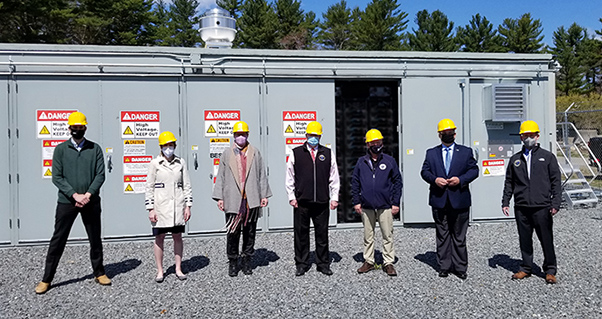
The primary purpose of the unit is coincident peak demand management for reductions during critical peak times when electricity is most expensive and to mitigate ISO New England’s need to dispatch less environmentally friendly generators.
In the 19 months that the BESS has been operational, the RMLD has realized net savings of $346,000 by reducing demand during annual capacity and monthly transmission peaks.
Lawmakers who attended the tour were Jeffrey Roy, new chairman of the Massachusetts Legislature’s Joint Telecommunications, Utilities, and Energy (TUE) Committee and six TUE Committee members: House Minority Leader Brad Jones, Senate Minority Leader Bruce Tarr, Rep. Joan Meschino, Rep. Kate Lipper-Garabedian, Rep. David Robertson, and Rep. Rich Haggerty.
APPA members invited to make board nominations for Region 2
May 5, 2021
by Paul Ciampoli
APPA News Director
May 5, 2021
The American Public Power Association is inviting member organizations from Region 2 to nominate candidates for a seat on APPA’s board of directors to represent that region on the board. Nominations must be submitted no later than May 21, 2021
Region 2 covers Illinois, Indiana, Michigan, Ohio, Wisconsin.
The nomination form can be found here to nominate deserving individuals for this important position.
The Nominating Committee will meet telephonically in late May to consider nominations for the Region 2 seat. The Committee’s recommendations for the new Board members will be presented and voted upon by the Board of Directors at the annual business meeting held in June during APPA’s National Conference.
Contact Cartina Parks-Williams at CParks-Williams@publicpower.org for questions regarding submissions.
SRP to more than double utility scale solar to 2,025 megawatts by 2025
May 4, 2021
by Paul Ciampoli
APPA News Director
May 4, 2021
Salt River Project (SRP) on May 3 unveiled plans to more than double its 2025 utility-scale solar commitment to now add a total of 2,025 megawatts (MW) of new utility-scale solar energy to its power system by the end of fiscal year 2025, driven in part by dedicated customer demand for new renewables.
This is more than 1,000 MW beyond SRP’s original 2025 commitment of 1,000 MW announced in November 2018, the Arizona-based public power utility noted.
As part of this 1,025 MW solar increase, 450 MW is enabled by an SRP commercial customer to meet its renewable energy commitments. All the renewable energy purchased is expected to be from solar energy developments built in Arizona or on the Navajo Nation and will ultimately be used by SRP commercial and residential customers.
SRP currently has 648 MW of utility-scale solar plants online or contracted and under development across the state and will add more than 1,375 MW of newly contracted solar power by 2025.
SRP recently contracted for the output from the Sonoran Energy Center, which will be the largest solar-charged battery project in the state, giving SRP one of the largest commitments to energy storage in the nation, it said.
The utility has also contracted for an additional large-scale solar and battery storage project at Pinal Central Solar Energy Center and is bringing online a new grid-charged battery storage project at Agua Fria Generating Station.
SRP’s latest solar field developments which came online in December 2020 include the 100 MW East Line Solar and the 100 MW Saint Solar. The two utility-scale solar fields serve commercial, municipal and educational customers who chose to participate in SRP’s Sustainable Energy Offering.
East Line Solar was built by developer sPower and is located in the town of Coolidge in Pinal County, Ariz., and solely serves Intel Corporation with 100 MW of renewable solar energy. Saint Solar was built by developer NextEra and is also located in Coolidge, Ariz., and customers currently receiving a portion of the 100 MW of renewable energy from this solar plant include Air Products, Albertsons Companies, Inc., City of Chandler, City of Mesa, City of Phoenix, CMC Steel Arizona, CyrusOne, Digital Realty, Freeport-McMoRan, Mesa Public Schools and Walmart.
Another utility-scale solar plant part of SRP’s Sustainable Energy Offering is Central Line Solar, a 100 MW solar field to soon be built by developer sPower in Eloy, Ariz., that will serve 21 SRP companies with renewable energy once the plant becomes operational in December this year.
Customers who will receive renewable energy from Central Line Solar include Apple, Inc., Arizona State University, Boeing, CenturyLink, Chandler Unified School District and Circle K Stores, among others.
SRP is already in the process of procuring the additional 1,025 MW of solar capacity from solar developers interested in building new generation resources in Arizona, it noted.
Washington governor tours Snohomish County PUD’s unique microgrid site
May 4, 2021
by Paul Ciampoli
APPA News Director
May 4, 2021
Washington State Gov. Jay Inslee, a Democrat, recently visited a Snohomish County PUD microgrid site. The Arlington microgrid is currently undergoing testing and commissioning and should be fully operational in a few months.
In 2018, the PUD received a grant from the state’s Clean Energy Fund to help build the Arlington microgrid. In fact, the grant covered a quarter of the costs to make the project feasible for the PUD, said Aaron Swaney, a Snohomish County PUD spokesperson, who noted that Inslee has been a champion of clean energy in the state of Washington.
The Arlington Microgrid project is funded in part by a $3.5 million grid modernization grant from the Clean Energy Fund, noted Washington State Department of Commerce Managing Director Jennifer Grove.
“We’re excited to support projects like this that demonstrate how clean energy technologies such as battery storage and solar can work together to provide the community with renewable energy and grid resilience. Commerce is accepting applications for the next round of grid modernization grants through 5 p.m. on May 18, with a focus on funding and technical assistance for earlier-stage planning and design efforts,” she said.
Inslee was interested in the progress of the project, Swaney said.
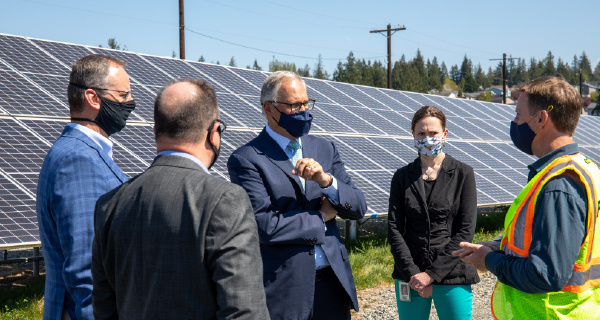
The microgrid is a very unique project, Swaney pointed out. “More than just a ‘microgrid,’ the innovative project is designed to demonstrate the multiple uses of energy storage: grid resiliency, renewable energy integration, grid support and electric vehicle integration,” Swaney said.
On top of that, the microgrid “could play a critical role in helping the PUD restore power in the case of a devastating earthquake in our region,” he said.
The area where the microgrid is built is near the Arlington Airport and a growing hub of industrial and commercial activity, including the recently announced development of a large Amazon facility.
Inslee received a brief tour of the different elements that make the microgrid unique:
- The Clean Energy Center, an educational hub that will host students and industry workers wanting to learn about the project;
- The Vehicle-to-Grid charging system;
- The 1 MW/1.4 MWh lithium-ion battery storage system; and
- A PUD 500-kilowatt Community Solar array.
PUD Arlington Microgrid Project Manager Scott Gibson led the tour of the V2G and battery storage system, while Community Solar Project Manager Suzy Oversvee talked about the PUD’s investment in Community Solar.
Inslee also chatted and joked with four members of a PUD Substation Construction crew who helped build the microgrid, Swaney said.
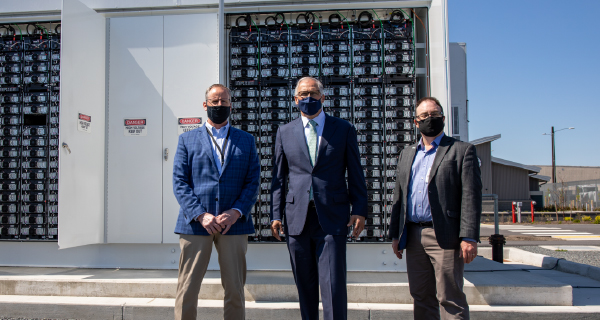
Swaney said that the project is undergoing testing and commissioning and should be fully operational by early July. “We are anticipating hosting a virtual ribbon cutting in late August,” he said.
There are many aspects of the project that are innovative, but three are truly unique and being studied closely, he said.
The pair of Mitsubishi Electric V2G chargers on site are one of the first utility deployed (non-demonstration) projects of its kind in the U.S. Nissan is a partner and Pacific Northwest National Laboratories is studying the use of V2G technology.
Second, the Hitachi-ABB PowerGrid’s Grid Forming Inverter helps ensure there is no power loss during the battery’s transition from powering the grid to acting like a generator to power the facilities on site. The University of Texas is studying the Grid Forming Inverter.
Finally, the PUD collaborated with several parties including Burns & McDonnell, Pacific Northwest National Laboratory (PNNL), MESA Alliance, other utilities, and the Arlington Fire Department (AFD) to create a battery storage system that maximizes functionality and safety.
“The battery fire suppression system was a great collaboration between PNNL and the AFD to create a system that is arguably the safest in the country if not the world,” Swaney said.
“We are planning to use this system to provide back-up power to a future office being constructed on the site (anticipated completion 2023),” said Gibson. “We are currently testing the system on the recently completed Clean Energy Center so that when it comes time to connect to the new office – we know that everything works.”
Chelan County PUD unveils new hydropower contract with Puget Sound Energy
May 4, 2021
by Paul Ciampoli
APPA News Director
May 4, 2021
Washington State’s Chelan County Public Utility District and Puget Sound Energy (PSE) on April 27 unveiled a new contract for hydropower from two PUD hydro projects on the Columbia River.
The five-year contract supplies PSE with 5% of the output from the PUD’s Rock Island and Rocky Reach hydropower projects from 2022 through 2026.
The contract complements an existing contract between the two utilities, while generating revenue for the PUD to provide continued rate stability for its customers, Chelan said.
PSE secured the contract following a competitive bidding process in the first quarter of 2021.
Chelan noted that the contract will bolster PSE’s supply of carbon-free energy, in line with the goal of becoming a “Beyond Net Zero Carbon” energy company by 2045, while also supporting Washington state’s Clean Energy Transformation Act goals.
Chelan PUD in March said that it is evaluating its strategies to sell carbon-free, surplus power as long-term energy output contracts expire over the next decade.
Chelan PUD General Manager Steve Wright on March 15 presented a plan that would support more economic growth locally, while also allowing the PUD to capitalize on favorable market conditions, the PUD said.
Guam Power Authority bolsters resilience and charts path to 50% renewables
May 3, 2021
by APPA News
May 3, 2021
In honor of Asian American and Pacific Islander (API) Heritage Month – commemorated each May – the American Public Power Association’s Public Power Current newsletter is proudly spotlighting the leadership roles our API colleagues have at public power utilities across the United States and at our U.S. territories in the Western Pacific. We kickoff our coverage by sharing updates from Guam, “a beautiful, tropical island with an equable climate and melting-pot of hospitable people,” according to Guam Power Authority General Manager John M. Benavente, P.E. said Guam “is a modern and culturally diverse community with practically all the amenities of living, similar to elsewhere in the U.S.” He encourages you to visit Guam and “enjoy the paradise of this island territory of the U.S.”
Our next feature article will highlight API public power leaders here on the mainland representing the many diverse Asian-Pacific Islander cultures from China to the Philippines, and India to Vietnam.
Guam Power Authority (GPA)
Håfa Adai. Guam is an unincorporated U.S. territory in the Western Pacific; for reference, it is located 3,950 miles west of Hawaii and 5,974 miles west of California. A progressive Pacific island community – and a strategically important link between the U.S. and Asia – there is a critical bond between energy and Guam’s economic advancement.

GPA supplies monopolistic electricity services, including to all U.S. military bases (the Navy is Guam’s largest customer), various governmental components, and a vibrant shopping and hotel plus tourism industry.
GPA serves 170,000 people (or 52,000 customers) with a 2019 peak demand of 254 megawatts (MW). The island community has evolved significantly from pre-WWII wood, lime mortar, and stone houses with thatched or Spanish tile roofs. Following typhoons Karen (1962) and Pamela (1976), today’s businesses and homes are made of reinforced concrete with typhoon shutters.
GPA has similarly undertaken significant system hardening initiatives: power plants are constructed with concrete or prefabricated structures to withstand 180 mph winds; vital power transmission lines are underground, with 60% of system load served through underground infrastructure; over 87% of GPA’s wood poles have been replaced with mono-tube, U.S. Navy-built octagonal concrete poles, and round, industry-spun concrete poles that can also withstand 180 mph wind speeds; and GPA continues its village underground hybrid system to place secondary lines (over 20%) underground too.
These investments have paid off. In September 2018, Category 2 Typhoon Mangkhut (106 mph winds) passed just north of Guam. Although 6% of GPA’s customers kept power during the storm, 51% of customers were restored by the next day – and 90% by the fourth day of restoration. Additionally, over 250 stand-by generators – supplied and maintained by GPA – ensured that 99% of all customers had uninterrupted water service during the storm.
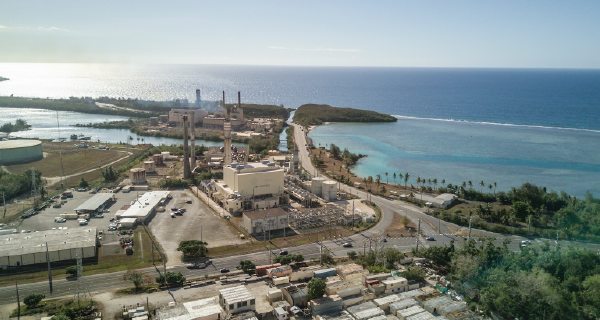
GPA employs 450 people and owns $955 million in assets, including 29 substations and 1,800 miles of transmission and distribution lines. It is governed by a 5-member Consolidated Commission on Utilities board, while the Guam Public Utilities Commission sets GPA’s rates and holds oversight authority over all large GPA contracts impacting rates and charges.
GPA supports Guam’s economy with both conventional fuel oil and renewable energy – currently, GPA has 25.3 MW of renewable capacity with an additional 160 MW of solar photovoltaic and 150 MWH of energy storage – which will help achieve a 25% Renewable Portfolio Standard mandate by 2024.
Benavente notes that GPA’s energy had been generated by fossil fuels for five decades, which made Guam vulnerable to and at the mercy of geopolitical fuel oil challenges. Fuel oil purchases total more than half of GPA’s budget. “It is a significant economic drain on Guam’s economy,” he said. “By converting fuel oil purchases to alternative energy purchases such as photovoltaics, Guam is converting oil to jobs, while at the same time reducing its carbon footprint and impact on the planet.”

GPA has signed contracts for the construction and operation of a 198 MW combined cycle plant with a thermal efficiency of 51% that is designed to be the cornerstone of GPA’s fleet.
“The plant will allow us to hedge against fluctuating fuel oil prices because over time we will continue to reduce the volume of fuel oil we use by substituting with photovoltaic energy sources. It will work well with renewables, and, in fact, will be the backup to renewable energy to ensure continuous power to the island, in the event of non-solar days and natural disasters.”
In addition, he said, “All renewables must have adequate storage systems for full capacity load shifting capability. All contracts will comprise a power purchase agreement for 25 years or more. The majority of this capacity will be utility-scale renewables, but the program would also include rooftop solar and small energy farms.”
“The [new Dededo Ukudu Combined Cycle Power Plant], coupled with renewables, will allow GPA to achieve 50% renewables, most likely before the end of this decade,” he added.

GPA has also been investing in Advanced Metering Infrastructure systems, upgrading its billing systems to accommodate 2,100 net metering customers, and has an ongoing Demand Side Management program to assist customers in lowering their total energy cost.
To attract and retain high quality staff Benavente explained that GPA “adopted a pay-for-performance employee pay structure, which rewards its employees and assures a competitive pay structure and benefits today, and into the future.” GPA subsequently became a premier employer of choice on Guam – always drawing significant interest and numerous applicants for positions. GPA also runs apprenticeship and other training programs.
GPA embraces the criticality in operating an island grid and working with local communities; geographic isolation presents unique challenges to disaster readiness and recovery for island communities. “From as far away as the U.S. Virgin Islands to the nearer Commonwealth of the Northern Mariana Islands (CNMI)-Saipan, GPA is committed to, and has provided, mutual aid assistance for recovery and restoration following devastation caused by natural disasters.” In 2019, GPA received APPA’s Mutual Aid Commendation award for having answered the call for help and assisting the devastated CNMI-Saipan community restore power and helping to rebuild an entire island economy.
GPA has also received a Smart Energy Provider designation from APPA, and was recognized as the first electric distribution utility to operate business critical functions on the Environmental Systems Research Institute’s Utility Network Data through tapping drones to digitally map power lines, poles and other hardware and help GPA with maintenance forecasting, deployment of manpower and equipment.
Within the next few years, GPA will have significantly shifted the paradigm in energy supply for customers by providing reliable energy at an affordable and stable cost and Benavente envisions that GPA “will begin the journey forward to fully underground the electrical power system within the next few decades, so that Guam becomes an even more sustainable island, less vulnerable to economic and natural disasters.”
Benavente is understandably very proud of the transformation that GPA has gone through. “Over the past 53 years, GPA, through its founding employees and today’s team of professionals and staff, has striven for sustainability and an ever-improving quality of life for our extremely remote island. Today, we see light at the end of the tunnel and this truly is exciting and commendable.”

We are pleased to introduce our readers to a few of GPA’s employees – some of whom you may have met at APPA events – and to celebrate their contributions to public power and our local communities during Asian American and Pacific Islander Heritage Month.
 John M. Benavente, P.E., General Manager
John M. Benavente, P.E., General Manager
An Asian/Pacific Islander himself, from Guam, he climbed through the GPA ranks and has held the leadership position for over 25 years. He has expertise spanning over four decades of technical, engineering, operations and executive leadership in the power and water utility-related fields across both the government and private sectors. Benavente is a licensed Professional Mechanical Engineer in Guam. He holds a Master of Science in Engineering Management from the University of Missouri (Rolla) and a Bachelor of Science in Mechanical Engineering from the University of Dayton in Ohio.
Benavente’s current efforts include addressing GPA’s core value strategies of providing a sustainable energy supply for Guam, hardening GPA’s grid infrastructure, workforce planning and management, building GPA’s new, combined cycle 198 MW Ukudu power plant, and achieving a 50% renewable energy supply for Guam by 2030.
He is particularly proud that “GPA has consistently placed highly, in the top three safety categories for its utility workforce safety performance. Safety is of primary importance to myself and my entire team, and GPA provides significant resources and training to ensure safety first, across all areas of the power utility. It will continue to strive to perform and be ranked among the safest electrical power utilities and do everything it can to send all workers safely home to their families each and every night.”
He is also proud to be part of GPA’s 53-year history, “having contributed to bringing GPA to where it is today, so that Guam becomes an even more sustainable island, less vulnerable to economic, natural and other disasters.”
“There is still much to do, but the good news is much will be achieved over the next several years, which will improve reliability substantially and bring energy costs to the affordable range for all customers,” he added.
Benavente has served on APPA’s Board of Directors since 2016, representing Region 10 that is comprised of American Samoa, Guam, the Marianas Islands, Puerto Rico and the U.S. Virgin Islands.
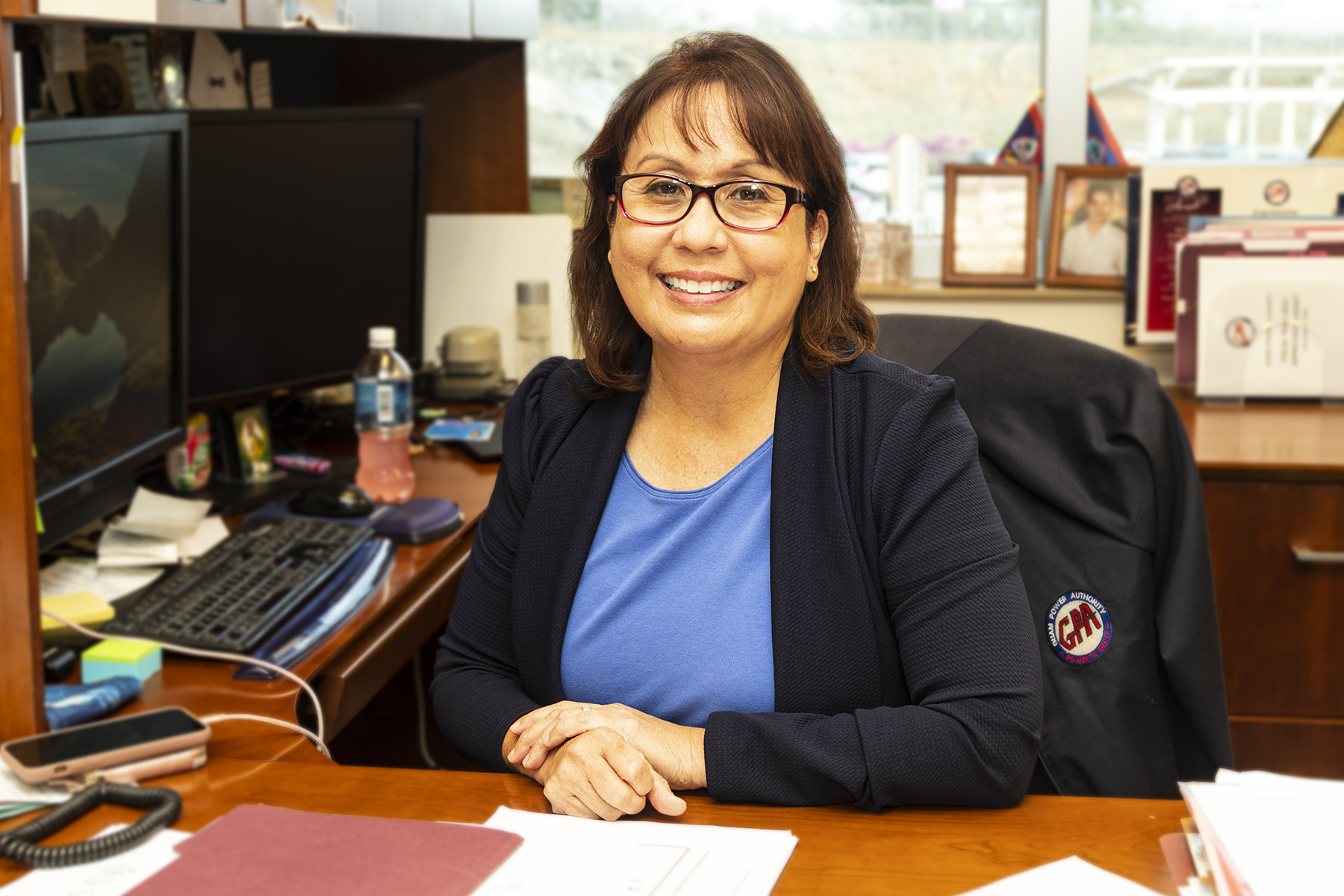 Melinda C. Mafnas, P.E.
Melinda C. Mafnas, P.E.
The opportunity to learn all aspects of the power system drew Mrs. Melinda C. Mafnas to public power.
A Chamorro woman and a home-grown talent, she received her Bachelor of Science degree in electrical engineering from the University of Hawaii at Manoa and is a registered Professional Electrical Engineer in Guam with 30 years of experience working at GPA.
Mafnas joined GPA in 1991 as an engineer. “I was not limited to design work. Once projects were completed and operational, I continued to work with generation, substation, and line electricians to enhance my knowledge and grow in my profession.”
She rose through the ranks, as the Supervisor of Distribution Engineering, then Supervisor of the Substation/Transmission Engineering section directing both medium and high voltage projects, and next as GPA’s Manager of Engineering responsible for the overall administration of engineering-related work.
“With this continued growth, I eventually became the Assistant General Manager of Operations in charge of power generation, transmission, distribution, and dispatching” she said.
Mafnas is the first woman in that role and now manages approximately 300 employees and a multi-million-dollar annual budget.
She said two things stand out to her: “Watching the growth and development of apprentices that become journeymen and grow into leaders. Equally amazing is knowing that everyday life on Guam is made possible by the service the Guam Power Authority delivers. I find joy and accomplishment helping customers. Every person that turns on a light switch and every child doing research online or attending virtual classes can do so because of GPA.”
When asked what she enjoys most about working for public power, Mafnas proclaimed, “I love my job!”
While operating an island power system is complicated and challenging by its very nature, she said that “Overcoming these challenges and providing stable, reliable power inspires me to do more. Knowing I am making a difference and a positive impact in the community is a great feeling. Power is an essential service and extending lines, troubleshooting issues, lighting up roadways, meeting the demand for power every hour of every day is rewarding. Students can attend classes, water is flowing to homes and businesses, roadways and villages are safe because of street lighting and security cameras, families anywhere in the world can communicate with loved ones on Guam through Face Time and virtual meetings because of the power GPA delivers to them.”
She said the hospitality of the people sets Guam apart from other places. “Guam is beautiful. The Guam Power Authority provides a vital service to the island and as GPA thrives, so does Guam.”
 John J. Cruz Jr., P.E., CEA, CEM, MBA
John J. Cruz Jr., P.E., CEA, CEM, MBA
Guam Power Authority’s Assistant General Manager for Engineering and Technical Services, John Cruz oversees several areas currently leading GPA’s transformation to a highly diversified, resilient modern power grid as well as driving its comprehensive digital transformation.
He holds a Bachelor of Science degree in electrical engineering, a Bachelor of Arts degree in mathematics, and a minor in business, from Gonzaga University in Spokane, Washington. He went on to earn a Master of Business Administration from the University of Phoenix.
Cruz has over 30 years of electric utility experience across multiple disciplines.
He began his career in 1982, working as a summer intern for GPA’s Engineering Manager. “In 1991, I was on a one-year leave of absence from Hughes Aircraft Company/Radar Systems Group to fulfill a request for assistance from my parents.” However, fate intervened, and he met his future wife at GPA and decided to stay. He accepted a job with GPA soon after returning to Guam.
Cruz said there were numerous, interesting challenges at GPA when he arrived. “I felt I could help solve or find solutions for some of those. Today, there are still challenges to overcome, and they are very exciting. Having joined GPA from another industry, I brought a different/external perspective on analyzing and understanding issues and the processes. As a multidiscipline systems engineer, I valued looking at things from different angles. I wanted to make a difference for the utility and in my community.”
Cruz and his teams provided the seminal ideas for, and executed, several of GPA’s key contracts and planning undertakings – including the acquisition of nearly $40 million of federal grants, the contracting for over 185 MW of renewable energy, and GPA’s Smart Grid Program.
“We have so many complex and difficult challenges and often have to span several disciplines to get the job done. Opportunities for great learning experiences are everywhere.
GPA is transforming across so many fronts with renewable energy, battery energy storage systems, smart grid, new flexible generation, information/operations technology, customer-facing digital applications, and more. These are exciting times. We get to do this through the lens of public service, making the ‘Power to Serve’ motto of GPA a reality.”
Cruz said that mentoring and staff development have been particularly meaningful for him. “Providing [staff] with great opportunities to grow in the engineering and technical profession. Many of the earliest employees I supervised have left Guam and GPA for opportunities on the U.S. mainland – working for CAISO, SEL, B&V, LEIDOS, and other firms. I am proud these staff attracted great offers and now work for renown mainland firms and instantly added value at the highest levels.”
Cruz notes that Guam is a unique American subculture. While also enjoying American sports and entertainment, “we are a unique society with deep, 4000-year-old roots, including 300 years as a Spanish colony and 123 years as an American territory” so Asian and Spanish cultural influences still run strong.
“We are a mixture of influences, a resilient people, and we are survivors. Our ancestors braved thousands of miles of open ocean, arriving to claim a place of their own. That spirit and determination still fuels us.”
 Jennifer G. Sablan, P.E., CEA, CEM
Jennifer G. Sablan, P.E., CEA, CEM
This pride in the resiliency of Guam’s people continues with Jennifer Sablan, a licensed Professional Mechanical Engineer in Guam. “People who live here are capable, resourceful and supportive. We are very resilient, especially during challenging times experiencing and enduring natural disasters. In the hardest of times, our strongly rooted familial values extend toward others and you just know that you are not alone and can make it through together,” she said.
Sablan joined GPA in 1995 as an Engineer I in the Generation Division, quickly engaged in the division’s processes and overall operations, and rose through the ranks.
She was appointed GPA’s manager of the Strategic Planning and Operations Research Division in 2017. She has 26 years of electric utility experience spanning technical, engineering, generation, operations and management.
Sablan holds a Bachelor of Science in Mechanical Engineering from Marquette University in Wisconsin and is a Certified Energy Auditor and Certified Energy Manager with the Association of Energy Engineers.
While in college her studies focused on power plants and Sablan intended to return to Guam. Working for GPA “seemed like the natural choice. Over the years I’ve seen challenges and progress within GPA and the passion from others who were leaders and/or came before me to provide safe, reliable and affordable electricity for the island.” She said this influenced her commitment to GPA as her career job.
In 2005, Sablan was appointed the project lead for GPA’s developing renewable energy acquisition program and integrated resource planning.
“Being part of new programs and projects that have a direct impact on our island community keeps me going,” she said. “It takes creativity and ingenuity to support some of the projects we’ve implemented over these past years in regards to funding, technical support and execution, which has helped to develop our island’s utility. It is awesome to look back at the discussions, planning and celebrations of these successes. It is also a great learning experience to bounce back from any shortcomings. I’ve been able to work with some great minds, continue my education especially on developing technologies, and meet a lot of people through various networking, which all support my work.”
She led GPA’s acquisition for its first utility-scale renewable energy contracts for a solar photovoltaic facility totaling over 25 megawatts. She has and continues to support additional utility-scale renewable energy contracts, which total over 120 megawatts of installed solar photovoltaic capacity.
Under her management, GPA’s first utility-scale Battery Energy Storage Systems project was commissioned in March 2021. It supports intermittent renewable energy, improves system reliability, and reduces costs for GPA’s ratepayers.
Sablan is focused on building GPA’s newest, combined cycle 198-megawatt baseload Dededo-Ukudu power plant, expected to come on-line in 2023, and which will further support additional renewables, replace aging units, address compliance requirements and improve system reliability.
She is particularly proud to “provide support in developing and executing programs and projects to contribute to GPA improving its services. GPA is moving forward, and I feel proud to have contributed to its progress and successes.”
